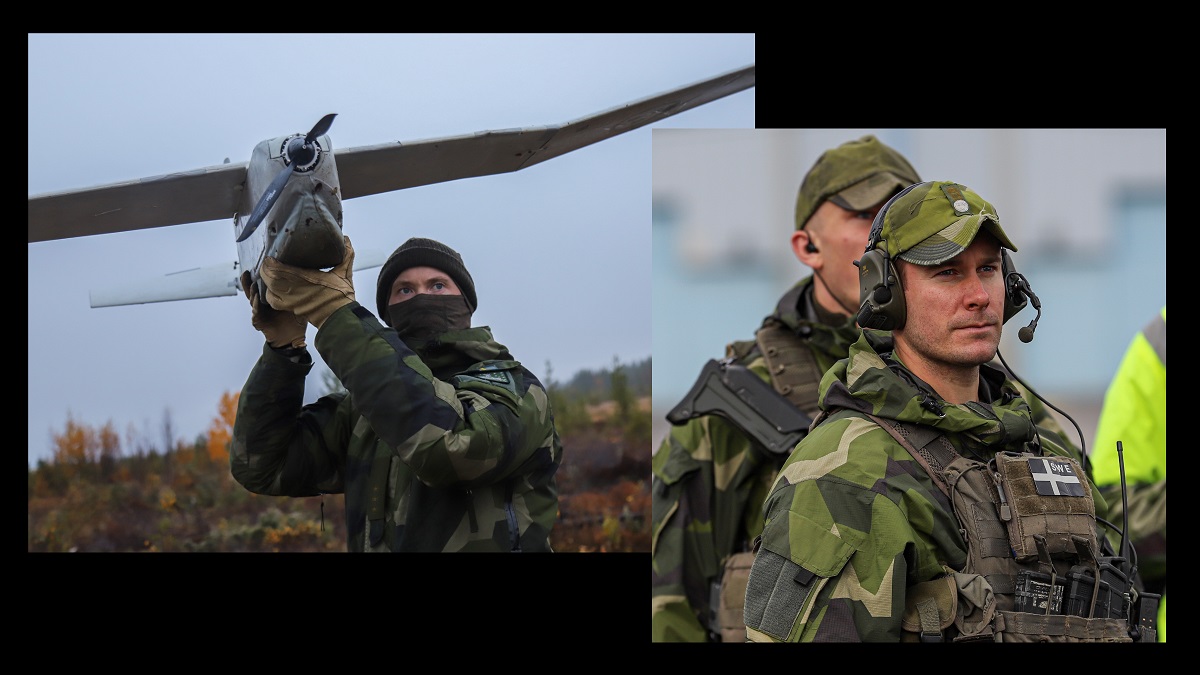
Russian aggression, amplified in 2022, continues to threaten regional and global stability. The Swedish Army’s response to this threat must be to integrate modern capabilities to counter conventional and unconventional Russian ones.
Like others, Sweden’s Army needs a transformation to meet the complexities of tomorrow’s warfare. Three main factors drive its current transformation needs: Russian aggression; Sweden’s recent accession to NATO; and the rapid pace of technological advancement. All these necessitate a reevaluation of the army’s strategies, capabilities, and overall readiness.
The Drivers of Action
Russian aggression, amplified in 2022, continues to threaten regional and global stability. The Swedish Army’s response to this threat must be to integrate modern capabilities to counter conventional and unconventional Russian ones. Besides such qualitative adjustments, the Swedish Army must expand its forces to meet and sustain a potential conflict in the Baltic region. Sweden’s recent accession to NATO fundamentally shifted the state’s past defense strategy of nonalignment in peacetime and its (aspirational) neutrality in war. NATO membership demands the Swedish military’s alignment with the alliance’s collective defense principles, interoperability, and agreed doctrines, standards, operations, and procedures to ensure its effective collaboration. This transformation will require significant changes in Sweden’s strategic culture and mindset, as to how it regards the general employment of its armed forces and specifically its army.
The rapid pace of technological advancement poses a third transformational challenge to Sweden’s Army. Innovations in cyber warfare, artificial intelligence, precision-guided munitions, and other emerging technologies are reshaping military operations and tactics. To maintain a competitive edge, the army must continually adapt, integrating new technologies into its existing capabilities to enhance effectiveness and respond to evolving threats. The army’s current structure, heavily influenced by Cold War era systems, is ill-suited to address future challenges. It is built on narrow national doctrines and legacy technologies, limiting Sweden’s ability to respond effectively to the diverse threats tomorrow’s warfare will pose. A multifaceted approach must involve strategies such as prototype warfare, system-of-systems integration, and other innovative approaches. The army must also adopt new doctrine and restructure its forces to remain effective in the new security environment.
New Approaches to Achieve Multi-Domain Operations
The Swedish Army’s new context requires a strategic doctrinal overhaul, particularly to align with Multi-Domain Operations (MDO). MDO aims at convergence –the integration and synchronization of operations across land, air, sea, cyber, and space domains, to enhance effects. This push reflects the complexities of modern conflicts, in which threats and opportunities cross multiple domains simultaneously, requiring a rapid, coordinated response. Domains are interdependent, with actions in one domain affecting outcomes in others. MDO strives to orchestrate this interdependence by synchronizing all actions across all domains, with emphasis on speed and agility, to achieve tactical and operational advantages. Adopting MDO has extensive implications for the Swedish Army. It requires a paradigm shift in current doctrinal and tactical approaches. Rather than fighting as a single service with joint support, the Swedish Army must understand its role as a land component serving in a joint, multinational force’s command.
Consequently, training programs must stress tactical thinking and decision-making in a combined, joint, multi-domain context. MDO also requires a transformation from domain-specific exercises to joint, all-domain exercises, focusing on cross-domain coordination and effects. Embracing MDO will compel a rethinking of the army’s structure and command systems. Traditional hierarchies with stove-piped command chains, designed for single-domain operations, must develop structures to coordinate simultaneous, cross-domain operations that maximize seamless interoperability with allies and partners in a NATO context. This will involve not only aligning Sweden’s Army to technical standards and protocols for communication and data sharing but also preparing it to participate in joint exercises and training programs with NATO allies. It will entail a pervasive cognitive shift toward understanding the new operational environment and its demands on Sweden’s forces.
Integrating new technologies and developing MDO capabilities require careful planning. MDO’s complexity necessitates not only adopting cutting-edge technologies but also integrating them seamlessly with legacy systems. This requires a multifaceted approach, involving methods such as prototype warfare, system-of-systems integration, and innovation development.
Prototype warfare is a flexible and adaptive strategy for military modernization which emphasizes collaboration with academia, research agencies, and industry partners. It emphasizes experimentation, testing, and iteration of new systems in real-world environments, which would allow the Swedish Army to assess and refine emerging technologies’ effectiveness in operational settings. Immediate feedback is used to improve systems before costly acquisition and deployment. Prototype warfare means establishing a framework for continuous experimentation with new technologies and deploying prototypes in training exercises where their performance can be evaluated without risking a mission’s success in a real-world scenario.
One of the risks of focusing exclusively on technical systems or technological advancements is the risk of performing so-called “innovation theater,” where new technological solutions are introduced without delivering tactical and operational advantages.
A system-of-systems (SoS) strategy can likewise ensure new technologies’ effective integration with legacy systems. Rather than viewing each new technology in isolation, SoS emphasizes seamless interaction between systems. In practical terms, it means using NATO processes and technical protocols to ensure that new technologies can work seamlessly in the alliance and with legacy systems and processes. An SoS operational environment enhances new technologies’ integration rather than creating functionality silos. As new technologies such as AI-driven decision support systems and autonomous platforms are introduced, it is crucial that these systems can communicate and operate in harmony with existing command structures. SoS integration supports the broader concept of MDO, in which seamless operations across all domains are critical. The SoS approach ensures that technologies designed for one domain can interact with and complement systems in other domains.
Capability innovation must go beyond a traditional focus on incremental material improvements such as thicker armor or longer barrels. It must embrace a broader, more holistic approach. One of the risks of focusing exclusively on technical systems or technological advancements is the risk of performing so-called “innovation theater,” where new technological solutions are introduced without delivering tactical and operational advantages.
New technologies demand new tactics, doctrine, and organizational structures. For example, autonomous or AI-driven platforms must harmonize new tactics to exploit these capabilities fully, rather than just attaching them to existing structures. Within a new framework, true innovation can occur, providing a relative advantage over adversaries. Capability innovation means the army must enhance its capacity for innovation at all levels, from the highest command down to the individual soldier. In parallel, it must foster an environment of continuous experimentation and adaptation to enhance performance and improve readiness.
Readiness demands a new Swedish force structure that is not only able to “fight tonight,” but which can also continuously evolve and integrate new technologies, tactics, and force structure strategies. The key components of this transformation focus on ensuring that the army’s warfighting units are ready for immediate deployment, for addressing material and personnel challenges, and for ensuring full interoperability with NATO standards.
Preparing for immediate deployment in combat operations not only means adopting standard technology and aligning the Swedish Army with NATO joint functions, such as command and control, maneuver, intelligence, fires, sustainment, information, protection, and civil-military cooperation. It also means restructuring the army’s chain of command to fit into NATO’s integrated command structure. Interoperability and robust “fight tonight” objectives will drive unit structure, personnel management, and resource allocation. Army warfighting units must be continuously assessed and resourced based on their ability to deploy and execute combat operations. This includes ensuring all units have the necessary weapons, equipment, and supplies to sustain combat operations in any environment.
Readiness for immediate deployment and combat operations extends beyond material preparedness. It includes the ability to mobilize a warfighting unit. This entails a reevaluation of the Swedish Army’s logistical and transportation capabilities. In parallel, existing equipment must be upgraded to ensure that it remains operationally relevant.
Force structure transformation requires a broad rethinking of Swedish military personnel management. This includes consolidating roles and responsibilities for professional, contracted soldiers and reservists. Experienced professional soldiers must continue to form the backbone of the army, preserving the skills to execute complex tactical operations. However, reservists’ roles must expand to include robust, intense training and exercises, corresponding with a higher level of readiness, to ensure they can engage an opponent on short notice. Reserves must be integrated as crucial components of Sweden’s overall military capability, with the same level of training, equipment, and support as their active-duty counterparts. Sweden’s small size and limited population has historically inclined it towards wartime conscription, which remains the only feasible way for it to muster a large army. Building one with conscripts requires highly focused training and exercises. Sweden is thus reinstating Cold War-era principles for fielding a sizable army efficiently and effectively.
A Never-Ending Journey
Constant evolution to meet new challenges and integrate new technologies means units will never be “finished,” but the army will instead perpetuate a holistic process, in which new technologies and tactics are being tested, refined, and integrated into the force structure. This evolution compels a culture of experimentation and curiosity, where all parts and levels of the army are engaged to embrace change and innovation. Such transformation must also strive to make Swedish units and warfighting functions interoperable with NATO standards. This is a shift of focus from technology-driven solutions to a system-based strategy, where personnel, organizations, and methods are integrated for maximum capability and readiness.
A once-again aggressive Russia has prompted Sweden’s abandonment of nonalignment and its accession to NATO. Any of the previous driving factors would alone stress the need for a change in the Swedish Army. As bundled challenges, they require swift and holistic cultural and organizational responses. Such challenges should, however, not be perceived as obstacles to overcome, but as opportunities to define what it means to be a modern army within an alliance.
Today’s Swedish Army must embrace a culture of force protection based on agility and flexibility, and of immediate readiness to deploy and engage. Swedish officers and soldiers must be as adaptable as the technologies they will use, and must be capable of operating in various contexts, in which the lines between warfare domains are increasingly blurred. The future of the army will be defined not only by its readiness and its ability to adapt and innovate, but also by its capability to defeat an enemy in an increasingly complex and interconnected battlefield. It is about creating an environment where every soldier is encouraged to innovate, to test new ideas, and to push the boundaries of what is thought possible. The Swedish Army’s transformation is about redefining its identity for the next century. Though challenging, this is an opportunity to build an army that is not only ready for combat operations today, but which is also prepared for tomorrow’s war.
MG Jonny Lindfors, LTC Jan Lundberg, and LTC Filip Scheynius are currently serving in the Swedish armed forces.
The views expressed in this article are those of the author and do not necessarily reflect those of the Swedish Ministry of Defense, the Swedish military, the North Atlantic Treaty Organization, U.S. Army War College, the U.S. Army, or the Department of Defense.
Photo Description: (L) A Swedish Army unmanned aerial vehicle (UAV) operator assigned to the Norrbotten Regiment prepares to launch a reconnaissance AeroVironment RQ-20 Puma UAV while (R) a Swedish close protection team soldier, assigned to Military Region North, provides supervision and security for incoming U.S. Soldiers participating in Nordic Strike 22, at Vidsel Test Range, Sweden, Sept. 27, 2022.
Photo Credit: U.S. Army photo by Spc Devin Klecan





From our article above:
“Russian aggression, amplified in 2022, continues to threaten regional and global stability. The Swedish Army’s response to this threat must be to integrate modern capabilities to counter conventional and unconventional Russian ones.”
But what if the much more primary threat that Putin poses to Sweden, to Europe, to the United States and indeed to the world; but what if this such much more primary and much more pressing threat is the threat posed by Putin’s (conservative?) ideas? Example:
“In his annual appeal to the Federal Assembly in December 2013, Putin formulated this ‘independent path’ ideology by contrasting Russia’s ‘traditional values’ with the liberal values of the West. He said: ‘We know that there are more and more people in the world who support our position on defending traditional values that have made up the spiritual and moral foundation of civilization in every nation for thousands of years: the values of traditional families, real human life, including religious life, not just material existence but also spirituality, the values of humanism and global diversity.’ He proclaimed that Russia would defend and advance these traditional values in order to ‘prevent movement backward and downward, into chaotic darkness and a return to a primitive state.’
In Putin’s view, the fight over values is not far removed from geopolitical competition. ‘[Liberals] cannot simply dictate anything to anyone just like they have been attempting to do over the recent decades,’ he said in an interview with the Financial Times in 2019. ‘There is also the so-called liberal idea, which has outlived its purpose. Our Western partners have admitted that some elements of the liberal idea, such as multiculturalism, are no longer tenable,’ he added. …
As Putin passes his 20th year as Russia’s president, his domestic and foreign policy appears intended to contrast his country’s ‘independent path’ with the liberal and decadent regimes in the West. The invented battle of Western values versus Russia’s ‘traditional values’ is part of a Kremlin effort to justify its broader actions in the eyes of Russian citizens, placing them in the context of a global struggle in which Russia is the target of aggression. Ignoring and violating the provisions of international organizations to which it is a party thus becomes a demonstration of defending its conservative values from European liberalism. … ”
(See the Wilson Center publication “Kennan Cable No. 53” and, therein, the article “Russia’s Traditional Values and Domestic Violence,” by Olimpiada Usanova, dated 1 June 2020.)
Bottom Line Thought — Based on the Above:
Thus, given Putin’s “battle of ideas” grand strategy above, it would not seem to be the physical boundaries of Sweden, Europe, the United States, the world, etc., that Putin seeks to assail but, rather, their mental boundaries/their boundary of ideas.
And, considering that President Trump, and more than 50 percent of the American electorate of late, many Europeans, and indeed many different people in many different states and societies around the world would seem to agree with Putin’s such (conservative?) ideas now, then — as to this such much more pressing threat — how should such entities as Sweden, Europe, the U.S., etc., plan and prepare to counter same today?
(Or, for the reasons outlined above, is this already a lost cause? Which might suggest that — sometime in the near future — Putin might be “invited” to cross states such as Sweden’s borders?)
Note that, as to the matters that I present in my comment above, Vice President Vance, at his meeting in Munich yesterday, seems to have more or less said that:
a. Liberal Europe is not seen so much as America’s ally anymore, as it (liberal Europe) is seen as America’s enemy now. And that:
b. Conservative Russia is not seen so much America’s enemy anymore, as it (Russia) is seen as America ally now.